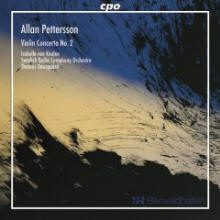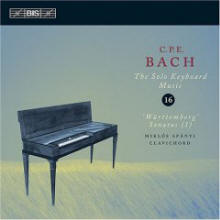|
You are reading the older HTML site Positive Feedback ISSUE september/october 2007
Notes of an Amateur - September, 2007, Part 2
Allan Pettersson, Violin Concerto No. 2, Isabelle van Keulen, violin. Swedish Radio Symphony Orchestra, Thomas Pausgaard, conductor. cpo 777-1992. Isabelle van Keulen, world class violinist with a rich and broad discography and more invitations to perform than she can possibly accommodate, didn't have to record this concerto by a little-known modern Swedish composer. But modern and contemporary music, especially by under-recorded composers, is one of her personal commitments. If it weren't, I would never have heard this work. At this stage of my life I follow musicians as much or more than composers, and she is one of my favorites. I met her in her double CD set for Philips made back in 1989 with Ollie Mustonen playing Stravinsky's music for violin and piano (long ago deleted but available as a reissue from ArkivMusik) and haven't let her out of my sight since. I heard her perform ‘live' at the Aldeburgh Festival in Suffolk, England in 2004 and had my enthusiasm confirmed. What we have here is an extraordinary piece of music, though I'm not sure I can persuade you that van Keulen and I are right about this. In the first place, the work rides in the upper registers – soloist and the whole violin section dominate the proceedings, which means you'd better have a CD player that can handle the treble range with grace. This range is the Achilles Heal of bargain digital front ends. If your player is hard and etched up there, forget it; if it flies from treble by rolling it off, you're no better off because you'll never know what makes this concerto tick. This is music of fury—and of the harsh and exquisite beauties contained within fury eloquently expressed. It is modern in its insistence on letting its nearly relentless passion define its form as well as its voice; but its melodic roots, such as they are, are late nineteenth century. This is the next step beyond Wagner and Richard Strauss. The solo violin sings and cries its music in the face and in the midst of the orchestra's insistence on its own predominance. It takes an extraordinary violinist to play this roll effectively. The music is challenging and the odds are sonically against her. When I put this recording on, my wife and son flew the environs. It has nothing to say to those who do not come to music for what this work offers. The modern poet Charles Olson describes poetry as resistance, as pushing back against the soulless, unpoetic world it finds itself in: the shape and tenor of the resistance reveal the human world that the poet asserts against the non-human one. His contemporary, poet Wallace Stevens, writes that art grows out of the imagination's conflict with Reality. Both poets are telling us that the resistance, the conflict, must be must be evident in the art or the work is simply an escape and of no use to us. Pettersson's concerto, which is the only piece of his music I know, powerfully exemplifies this view. I urge it upon you, especially if you want your musical expectations challenged. But do send the family out to a movie!
Carl Philip Emmanuel Bach, The Solo Keyboard Music, Volume 16, ‘Württemberg Sonatas (I). Miklós Spányi, clavichord. Bis Records 1423. There is more than a little resistance to the father in the music of J.S. Bach's most capable son, CPE Bach. The elder Bach's music has a built-in momentum (which jazz musicians who love him recognize as ‘swing'), which performers resist at the risk of losing him altogether. CPE's music, sometimes as intricate and architecturally impressive as JS's, take its distinctive character from having virtually no momentum at all. Coming to it from JS Bach, it sounds wayward. Miklós Spányi, who with the sponsorship of Bis Records has made himself virtually the younger Bach's champion interpreter on the keyboard, clearly feels that focusing on this aspect of the composer's style is the most direct way to his essence. (This is Volume 16 of the solo keyboard music and Volume 17 is already out; and his traversal of the keyboard concertos has reached Volume 15.) In Spányi's hands, CPE can be, especially in slower movements, ruminative, speculative, whimsical, willful, sometimes almost conversational. He verges on being the Andrew Hill of the clavichord! The allegros sound more like his father's, though here the rebellion comes through in dynamics, moving from loud to soft and then back again, with almost startling irregularity. The clavichord used in this recording is a richer sounding and more dynamic instrument that we are accustomed to hearing. Spányi is a student of eighteenth century keyboard instruments as well as the music played upon them and finds this particular instrument's "robust, rich, and well defined sound" perfect for these sonatas; and it's hard to argue with him. It does sound quite wonderful. The only other musician I've heard on this music is the pianist and conductor Mikhail Pletnov, who plays eight sonatas and rondos on a modern grand piano. (Deutsch Gramophone DG 289-459-614). Pletnov agrees with Spányi about how whimsically and willfully to play Bach, which is reassuring to a non-musicologist like me. But the modern piano, whose forte in particular is considerably more so than a clavichord!, transforms this music into something altogether different: the eighteenth century refracted through the twentieth. A truly great show, though if you listen to eighteenth century keyboard music because you enjoy its intimate scale, elegance, introspection, and the like, you'll likely be happier with Spányi.
Beethoven, Piano Sonata No. 28, Opus 101; No. 29, Opus 106, "Hammerklavier." Mitsuko Uchida. Philips 9419. When Lucy Honeychurch in E.M. Forster's novel, A Room with a View, has her moderately rebellious nature attributed to playing "too much Beethoven" on the parlor piano, we know what her critic is concerned about. Beethoven's piano sonatas have a tendency to let small feelings bloom (burst?) into larger ones, to let quiet conversations become loud and contentious ones. As if to say, that is the nature of human reality: there are large feelings lurking within small ones, heated arguments suspended in civil exchanges. And if music is to become truer to us, we must unleash it a bit. We all know that Beethoven was the beginning of something; and for me, this is what it is. We hear it most clearly in the piano sonatas. We hear the beginning of the world we now inhabit, where fewer secrets are kept, fewer feelings repressed, fewer truths kept at bay. If you doubt me on this, play Beethoven's Piano Sonata No. 28, opus 101 for a friend who continually tells you how much he or she "loves Mozart," and watch the reaction! Mitsuko Uchida, one of our truly great contemporary pianists, comes to Beethoven from superb complete cycles of Mozart and Schubert. This is her second CD of the late piano sonatas (no word yet whether there will be a complete set), and like the first [https://positive-feedback.com/Issue25/neill.htm], it is absolute Beethoven. The quieter passages are exquisitely lyrical (lyrical, not romantic or sentimental); the passages they grow into are big, bold, and magnificent. As always with Uchida, there is a stunning sense of clarity to everything: it is as if she wants us to see everything as well as hear it. And there is also more drama and contrast than flow to her Beethoven, which tends to increase the sense of clarity. The featured sonata here is the legendarily difficult and stormy "Hammarklavier," No. 29, Opus 106. It does help to come to it from No. 28! A small storm to prepare us for the hurricane. Her performance of this work makes the strongest case for it I've ever heard. You can find more refined and certainly more domesticated versions. But I doubt you'll find one with Uchida's emotional range (tenderness, drama, passion) and pure eloquence. How can anything this colossal encompass so much stillness! It is truly thrilling to feel yourself securely in the hands of a musician who holds nothing back and yet never misses a step. Systems used for these auditions: Audio Note CD2.1x II one-box player; OTO integrated amplifier, K/SPe speakers; Audio Note AN-Vx interconnects and Lexus speaker cable. Audio Note CDT 3 transport, Dac 4.1 Balanced Signature, M6 preamplifier, Neiro monoblock amplifiers, E/SPx SE speakers; Sogon and AN-Vx interconnects, SPx speaker cable. Bob Neill, in addition to being an occasional equipment and regular music reviewer for Positive- Feedback Online, is also proprietor of Amherst Audio in Amherst, Massachusetts, which sells equipment from Audio Note, Blue Circle, Manley Labs, and JM Reynaud, among others.
|



